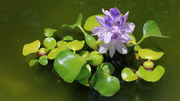
Table of Contents
Water Hyacinth (Eichhornia crassipes) is a highly favored floating plant in ponds for both its beauty and role in maintaining a balanced ecosystem. This aquatic plant features thick, glossy leaves and stunning lavender-to-pink flowers, adding aesthetic appeal to any water garden. But beyond its decorative charm, common water hyacinth serves a functional purpose by acting as a natural filter, absorbing excess nutrients in the water, which helps reduce algae growth and improve water quality.
If you're planning to add water hyacinths to your pond or water garden, here’s a simple care guide to help you manage this useful yet potentially invasive plant.
Optimum Conditions for Growing Water Hyacinth
Water hyacinth thrives in full sun and warm temperatures, making it an excellent summer plant for ponds and water features. Eichhornia crassipes grows rapidly in temperatures ranging from 60°F to 80°F (15°C to 27°C), especially when exposed to plenty of sunlight. For optimal growth, ensure that your pond or water hyacinth pond receives at least 6 hours of direct sunlight each day.
Planting Water Hyacinth
As a floating hyacinth, this plant doesn’t need soil or to be planted directly. Simply place the hyacinth water plant on the surface of your pond, allowing its roots to dangle freely in the water. It's important to space them out, as water hyacinth tends to multiply quickly. To help manage overgrowth, you can keep them contained within floating rings, which makes maintenance easier.
Thinning and Regular Maintenance
A critical part of water hyacinth care is controlling its growth. Since Eichhornia crassipes is considered an invasive species in many regions, it can rapidly overtake your water feature. Regular thinning is necessary to prevent the plants from covering the entire pond surface, which would block sunlight from reaching submerged plants.
To thin water hyacinths, you can remove excess plants by hand or use scissors to cut through tangled roots. Always dispose of extra plants responsibly—never dump them in natural waterways, as doing so could disrupt local ecosystems.
Nutrient Management
During the summer, common water hyacinth can absorb so many nutrients that it may starve itself. If you notice yellowing leaves or a decline in blooming, this may indicate that the plants are running low on nutrients. You can rejuvenate them by placing the water hyacinths in a bucket filled with water mixed with a soluble fertilizer for a few days. Once they perk up, rinse off the fertilizer before returning them to your water hyacinth pond.
If you're concerned about the plant taking over your pond, you can use a biological filter or confine the hyacinth water plant to a small container, such as a Patio Pond, which limits its growth. For those living in areas where Eichhornia crassipes is considered invasive, be sure to check local regulations before introducing it into your water feature.
Conclusion
The water hyacinth (Eichhornia crassipes) is a beautiful and functional addition to any pond or water garden. With proper care and regular maintenance, this floating hyacinth can enhance not only the aesthetics of your water feature but also contribute to a healthy pond ecosystem. However, due to its invasive nature, it’s crucial to manage the plant by thinning it out regularly and keeping it balanced with the rest of your aquatic environment. By following these water hyacinth plant care guidelines, you’ll be able to enjoy its beauty without the risk of overgrowth.







